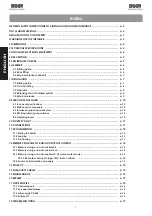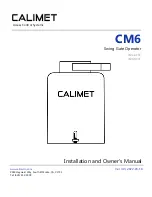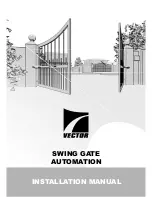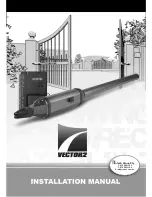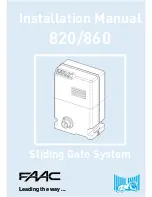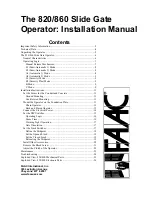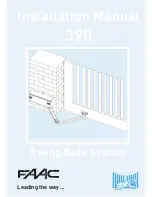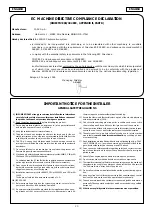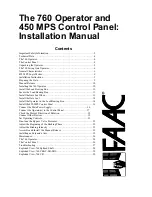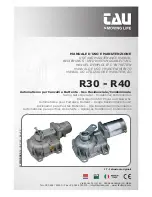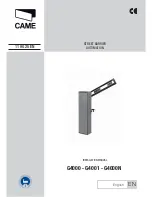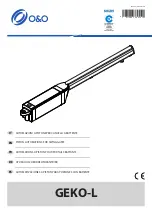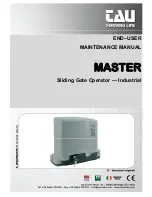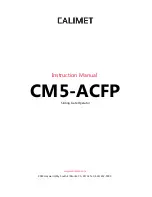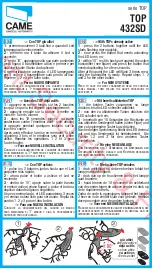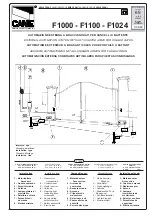
AUTOMATED SYSTEM 740-741
Read the instructions carefully before using the product and keep
them for future consultation.
GENERAL SAFETY RULES
If installed and used correctly, the 740-741 automated system will
ensure a high degree of safety.
Some simple rules regarding behaviour will avoid any accidental
trouble:
• Do not stand near the automated system and do not allow
children and other people or things to stand there, especially
while it is operating.
• Keep radiocontrols or any other pulse generator well away from
children to prevent the automated system from being activated
involuntarily.
• Do not allow children to play with the automated system.
• Do not willingly obstruct gate movement.
• Prevent any branches or shrubs from interfering with gate mo-
vement.
• Keep light signalling systems efficient and clearly visible.
• Do not attempt to activate the gate by hand unless you have
released it.
• In the event of malfunctions, release the gate to allow access
and wait for qualified technical personnel to do the necessary
work.
• After enabling manual operation, switch off the power supply
to the system before restoring normal operation.
• Do not make any alterations to the components of the auto-
mated system.
• Do not attempt any kind of repair of direct action whatsoever
and contact qualified personnel only.
• Call in qualified personnel at least every 6 months to check the
efficiency of the automated system, safety devices and earth
connection.
DESCRIPTION
The 740-741 automated system is ideal for controlling vehicle access
areas of medium transit frequency.
The 740-741 automated system for sliding gates is an electro-mecha-
nical operator transmitting motion to the sliding gate via a rack
pinion or chain appropriately coupled to the gate.
Operation of the sliding gate is controlled by an electronic control
unit housed inside the operator or in a hermetically sealed outdoor
enclosure.
When, with the gate closed, the unit receives an opening command
by radiocontrol or from another suitable device, it activates the
motor until the opening position is reached.
If automatic operation was set, the gate re-closes automatically
after the selected pause time has elapsed.
If the semi-automatic operation was set, a second pulse must be
sent to close the gate again.
An opening pulse during re-closing, always causes movement to
be reversed.
A stop pulse (if provided) always stops movement.
The light signalling indicates that the gate is currently moving.
For details on sliding gate behaviour in different function logics,
consult the installation technician.
The automated systems include obstacle-detection and/or safety
devices (photocells, edges) that prevent the gate from closing
when there is an obstacle in the area they protect.
1
2
3
1
2
3
Fig.0
Fig.02
User’s guide
The system ensures mechanical locking when the motor is not ope-
rating and, therefore, it is not necessary to install any lock.
Manual opening is, therefore, only possible by using the release
system.
The gearmotor does not have a mechanical clutch and, therefore, it
is coupled to a unit with an electronic clutch offering the necessary
anti-crushing safety if the system is completed with the necessary
safety devices.
A convenient manual release with customised key makes it possible
to move the gate in the event of a power failure or malfunction.
MANUAL OPERATION
Warning:
Cut power to the system to prevent an involuntary pulse
from activating the gate during the release manoeuvre
To release the operator proceed as follows:
1) Insert the key provided and turn it clockwise as shown in Fig. 01
ref. 1 and 2.
2) Turn the release system clockwise, until the mechanical stop is
reached, Fig. 01 ref. 3.
3) Open and close the gate manually.
RESTORING NORMAL OPERATION
Warning:
Cut power to the system to prevent an involuntary pulse
from activating the gate during the manoeuvre for restoring
normal operation.
To restore normal operation proceed as follows:
1) Turn the release system anti-clockwise, until its stop is reached,
Fig. 02 ref. 1.
2) Turn the key anti-clockwise and remove it from the lock, Fig. 02
ref. 2 and 3.
3) Move the gate until the release system meshes (corresponds to
gate locking).
4) Power up the system.
MAINTENANCE
To ensure trouble-free operation and a constant safety level, an
overall check of the system should be carried out every 6 months. A
form for recording routine maintenance operations is enclosed.
REPAIRS
For any repairs, contact the authorised Repair Centres.
AVAILABLE ACCESSORIES
Refer to catalogue for available accessories.
Summary of Contents for 741
Page 1: ...740 741...











